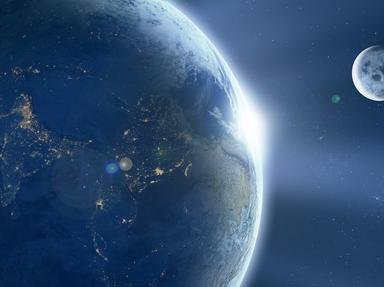Quiz Answer Key and Fun Facts
1. The Moon is Earth's only natural satellite, but in comparison with the planet it orbits, our Moon is the largest (proportionally) in the Solar System. Of these other large moons out there, which one is bigger than ours?
2. Our moon is locked into a synchronous rotation with the Earth, meaning that it rotates on its own axis in the same amount of time as it takes to orbit around the planet (so the same side always faces Earth). What is the Moon's orbital (and rotational) period?
3. The orbital period of the moon is slightly different than the synodic period, which relates to the Moon's position relative to the Sun as seen from Earth (the phases of the moon). Measuring from new moon to new moon, how long is the Moon's synodic period?
4. The gravitational pull of the Moon (and, to a lesser extent, the Sun) causes the rise and fall of the oceans known as high and low tides. What is it called when both the Sun and the Moon combine their pull for a higher-than-normal tide?
5. The observation of the Moon from the Earth has been ongoing for millennia, but one of the first works ("Sidereus Nuncius") that described the Moon through telescopic observation was published in 1610 by which famed Italian astronomer and scientist?
6. Does the Moon have an atmosphere?
7. Named for the Greek goddess of the Moon, what is the study of the surface and physical features of the Moon called?
8. Located within the Oceanus Procellarum (the largest of the Maria) is the brightest feature on the Moon's surface - an impact crater named for the Ancient Greek astronomer who first came up with a heliocentric model of the Solar System. What was his name?
9. Mons Huygens, the largest mountain on the Moon, can be found in Montes Archimedes, the range of mountains found at the northern edge of Mare Imbrium.
10. On the far side of the Moon, right near the center, a crater exists that is the proposed site of a giant radio telescope that would be shielded from all radio transmissions from the Earth. Named for the builder of the Labyrinth in Greek mythology, whose son flew too close to the sun, what is the crater called?
Source: Author
reedy
This quiz was reviewed by FunTrivia editor
rossian before going online.
Any errors found in FunTrivia content are routinely corrected through our feedback system.


